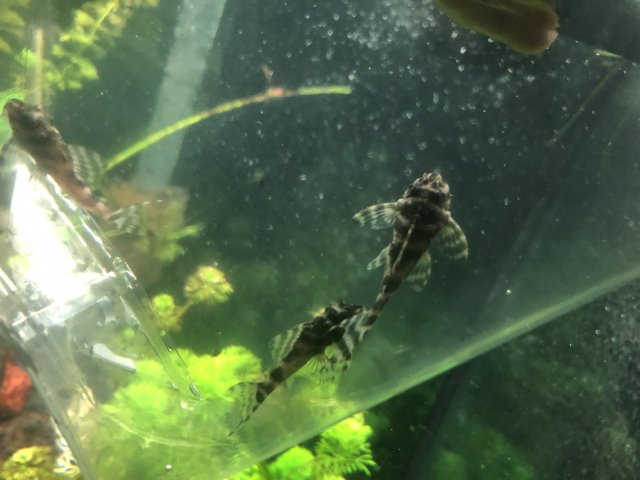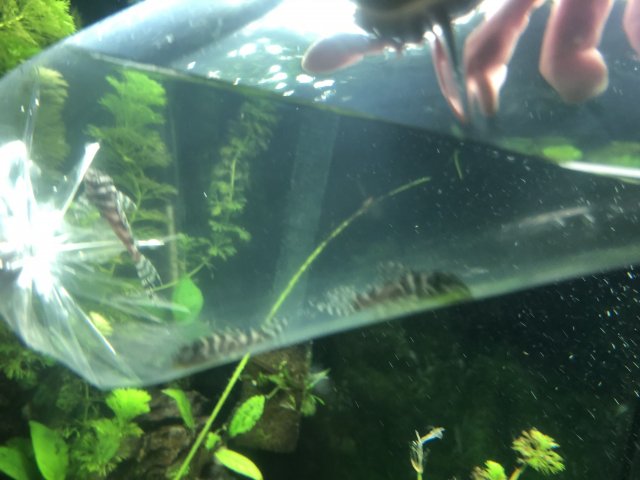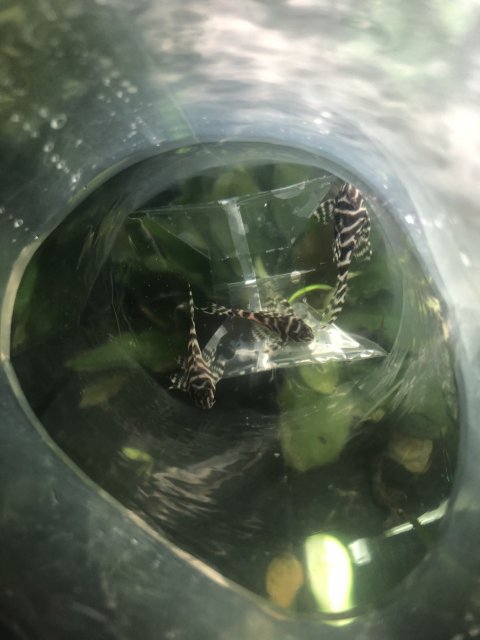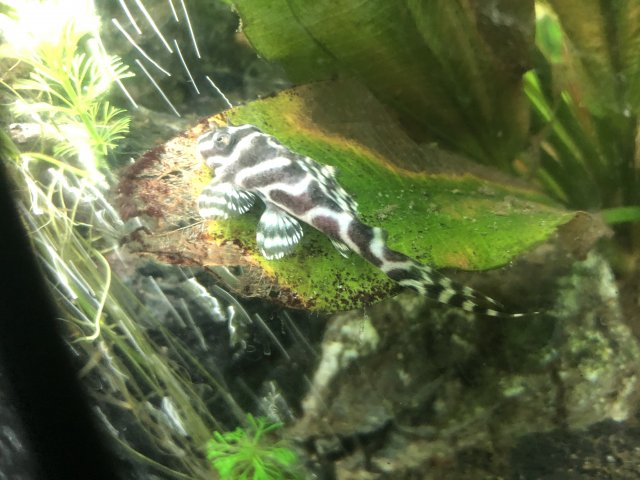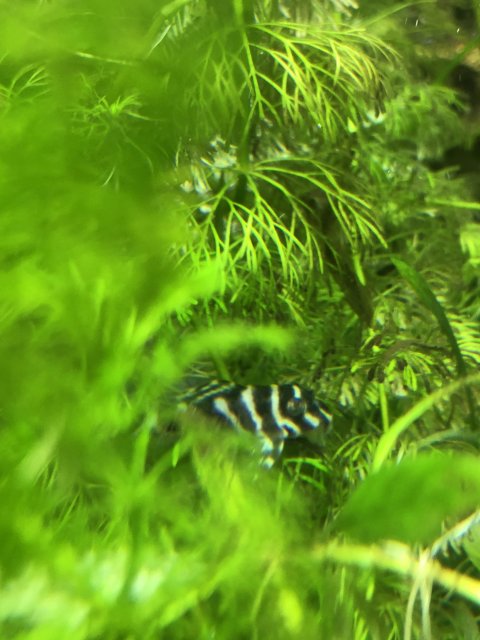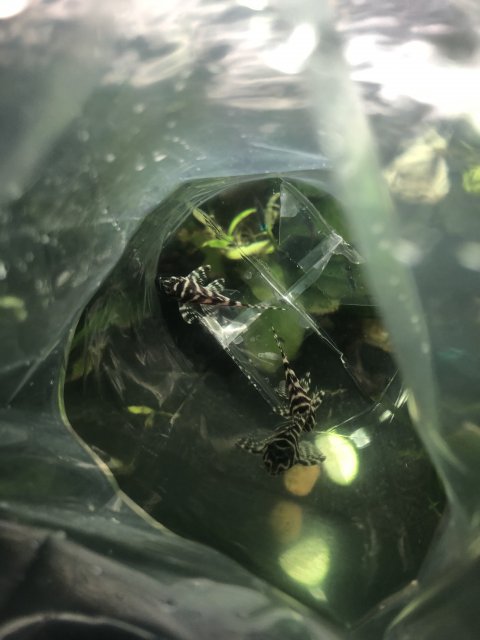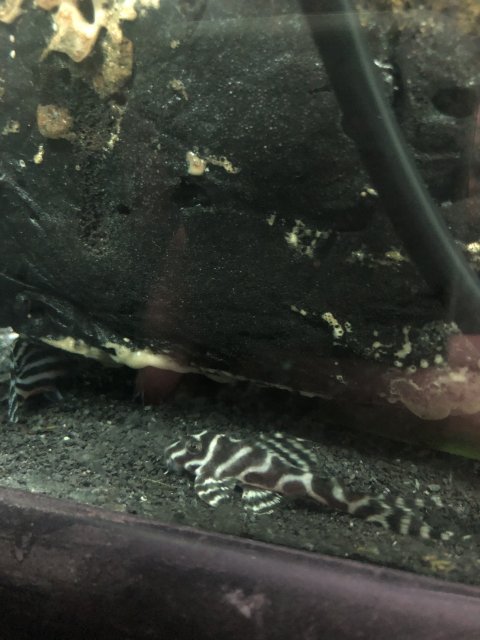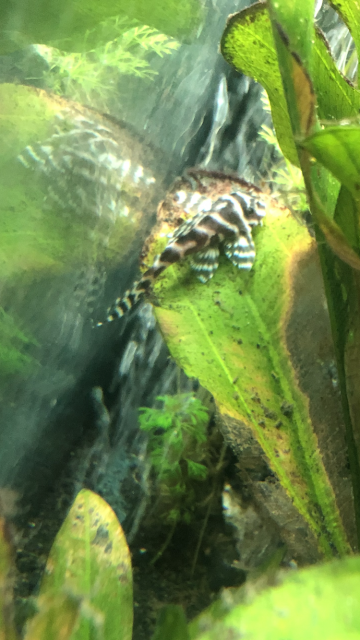Did you think I was saying you were a legend and whatnot? I was not.That is quite flattering ☺ Thank you
Project L236
- Thread starter Niki_up
- Start date
You are using an out of date browser. It may not display this or other websites correctly.
You should upgrade or use an alternative browser.
You should upgrade or use an alternative browser.
Well let me just pack my ego away in my suit case.? hahahDid you think I was saying you were a legend and whatnot? I was not.
I am working up a post on the three plecos. But I had to jump back in to post that my super white 236 group has spawned. i have a dad on wigglers . There is a male in the next cave that had a trapping with not spawn last week. it is possible he is also on eggs. he would not let me see. At this time all 7 of my hypancistrus breeding groups are actively spawning.
Thanks for the kind words, but I am really not a legend, I am just very lucky to have well water that apparently contains a natural fish aphrodesiac.
Thanks for the kind words, but I am really not a legend, I am just very lucky to have well water that apparently contains a natural fish aphrodesiac.
Please do post pics of your super whites!!I am working up a post on the three plecos. But I had to jump back in to post that my super white 236 group has spawned. i have a dad on wigglers . There is a male in the next cave that had a trapping with not spawn last week. it is possible he is also on eggs. he would not let me see. At this time all 7 of my hypancistrus breeding groups are actively spawning.
Thanks for the kind words, but I am really not a legend, I am just very lucky to have well water that apparently contains a natural fish aphrodesiac.
I have very few and not great pics of the 236. I did not take any when they arrived.However, in July 2020 I did remove all the contents of the tank and shot some pics. While I have 13 fish I shot whatever I could get. the fish were moving around, so in the few pics below it is very possible some fish appear more than once. Warning, i am a much better fish keeper than I am a photographer.
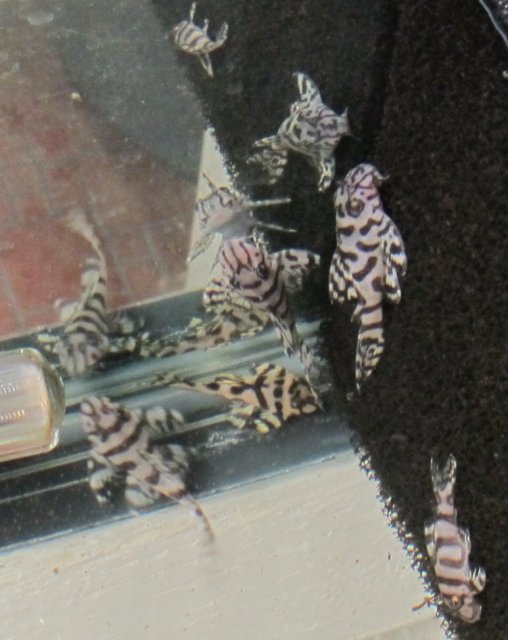

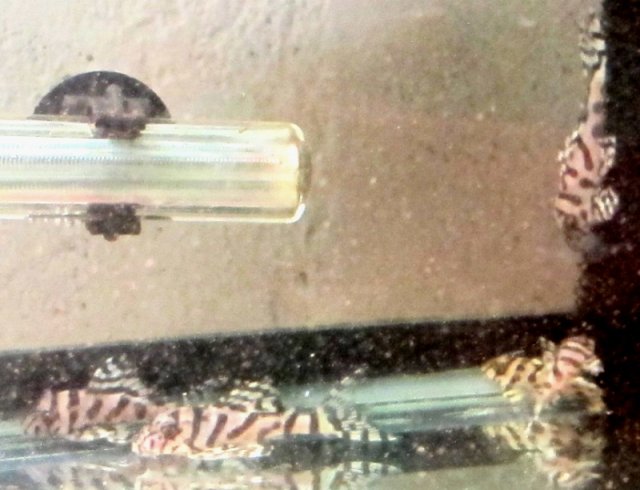
I will post the info about the three fish in another post below.



I will post the info about the three fish in another post below.
Here is the promised info on zebra/236/173:
Price to obtain- highest to lowest.
173
zebra
236 (the superwhite variety would be at the top of this list)
Max Size- biggest to smallest
236 (this is a close call as some 173 seem bigger and vice versa)
173
zebra
Speed of growth- fastest slowest.
236
zebra
173 (very slow)
Time from birth to spawning.
236- 2 years +/-
zebra 2.5-3 (Longer with groups, faster with a pair or reverse trio). The bigger the female, the more eggs she should produce.
173- 4 - 5 years
Time to spawning after free swimming- relative to adult size.
236
zebra
173
Observations re caves.
Zebras appear to prefer the typical rectangular cave that is a tight fit. Slate seems to be a favorite material but terra cotta is a very close second.
236 when younger prefer a clamshell shaped cave but as they gain more size they switch to a larger size rectangular shape.
173 have used only rectangular and D saped caves.
(I have not tried more than the above shapes/materials.)
Eye color.
zebra often have a blue hint in their eye color
173 should always have gold eyes
236 may have gold or may have black.
Which are or may become identified species?
H. zebra is identified and is an accepted species.
173 may one day become identified.
236 is likely not a species. But is a natural hybrid.
(The 173/236 are my personal opinions. However, in discussions with some of the bigger international names in plecos, I have had a couple concur.)
Patterning.
Zebras always have fairly straight horizontal stripes to the tail. Often a body stripe continues into and through the tail. Zebras are very easy to identify almost from the moment they go free swimming until the day they die. There is very rarely enough variability in them to make them appear as something else. They do not morph much with time.
236 is highly variable. This is true both in term of their tendency on an individual basis, to morph with time. It is even more the case between individuals. Even with super whites there is no real consistency of pattern in the same spawn. This can make it harder to identify them. it also means it is hard to know what you will get when staring with younger/smaller fish. They morph with time.
173 is even harder to ID when young. The ideal pattern people want is the zig- zag stripes down each side. I have never seen this in my fish when young. Many will go though a stage where they become somewhat zebra looking. But if one knows zebras, they know the 173 is not one. As they get ready to spawn the stripes morph into the zig zag pattern. When they gate much older they may loss the clear zig-zag and the black stripes may get fatter. They morph with time.
Feeding.
This is one area in which they are all the same. The are omnivores which prefer meaty foods. I consider diet to be one of the key factors in inducing spawning. Using commercial flakes and sinking sticks or wafers will not do the trick. Live foods work best. However, these were never a good option for me so I have relied on a combination of frozen and Repashy foods.
It is also important to understand that newborn fry and youngsters need small sized foods. They will try to eat larger size stuff and can choke to death on it. My go to foods for the fry/smaller fish is are frozen cyclops, rotifers and daphnia as well as BBS, I do not hatch my own and the frozen ones are pretty pricey. But I keep some in my freezer for those times I can only feed fry and have almost no time to do it.
Youngsters can also eat the Repashy. They also need some vegetable material when very young (moreso than when older). My practice with the Repashy is to mix either the Spawn & Grow or the Bottom Scratcher with the Soilent green. I shoot for an 80% to 20% meaty to veggie mix.
For the older fish I use frozen mysis , blood worms, spirulina gut loaded brine and brine shrimp. I often mix them all together. For growout tanks with some larger offspring I may use the SF bay Mini bloods, for bigger fish it’s the full size bloods. I get as many of the frozen stuff as I can from Jehmco. (There are two sizes of mysis avalable. I use the larger nysis only for bigger size fish.)
Finally, about a maximum of 15% of the time I will feed commercial foods, i.e. sinking sticks or mini-sticks and meaty wafers (I get these all from kensfish.com which may not be the absolute most nutritious brand of such foods. The smallest fish can eat these as they get soft.
Water parameters.
This is another area where all three of these fish are the same as they all come from the Volta Grande (Big Bend) of the Rio Xingu. This is a portion of the river that has lots of rapids as well as deeper waters. The rapids keep the water well oxygenated as the water is quite warm. These fish are small compared the other fish which might eat them. They are also liable to get picked off by birds if the fish are to near to the surface and in view. So they tend to hide a lot and love cover.
The Xingu used to be a seasonal river. The advent of the Belo Monte dam at the up river start of the Big Bend had done away with the seasonality. Moreover, the organization running the dam has recently been given permission to lower water levels 15% more than originally allowed for conservation reasons. I believe zebras and many other fish will not survive in the wild over the long run. Fortunately, there are many hobbyists and a few major breeding farms that now supply the world with zebras.
The water in the Xingu is clear and had very little solid (organic or otherwise) in the water. The pH tends to be in the 6.5 to 7.0 range depending upon the season. The water is also soft. Temps can range from the mid to high 70sF to as much as 90+F. However, when it comes to captive breeding parameters do not seem to matter very much.
Spawning triggers.
People have bred these fish in water ranging from the 6.5 to 8.0 pH and from soft to approaching hard water parameters. They appear not to be fussy in this respect.
These fish all thrive on change. This is what can trigger them to spawn. What matters is there is a difference in the parameters between the peak rainy and peak dry seasons. The GH or TDS are most important, before I got an RO/DI unit for my Altums, I used to use my 83 ppm TDS tap as the rainy season and to create the dry I would alter the tap in a 20 gal. Rubbermaid can for a day.
I ran a H.O.T. Magnum with the carbon basket filled with crushed coral for about 24 hours. Then I would add Epsom salt and a small pinch of baking soda to the water. This was used to change water in 33 longs. I raised the TDS overt time until they were at about 175 ppm in the tank. At the same time the temp. was raised to the low 90sF (usually max at 92F)
To onset the rainy I did two huge water changes (over 2 or 3 days) using pure tap at about 75F. Heaters need to be turned down at the same time. What I ended up with was about 76-78F tank temps. These were fair soon raised back into the low 80sF.
If you have harder tap water, then you will have you e the reverse method. You will need to use Ro water to onset and hold the rainy season and then over several months mix tap and RO to bring your tank back to normal tap levels.
Weather conditions.
One factor out of our control but very helpful for inducing spawning is the onset of a storm. These are accompanied by a significant drop in barometric pressure and the fish are able to detect this. So, if one can time the onset of a rainy season to the arrival of a rain or snow storm, this will help greatly. In fact doing a feeding regimen to induce spawning combined with the onset of a storm is enough to induce spawning. it may also take a drop in the water temp. of a few degrees.
Finally, it is essential to induce spawning to be feeding high quality foods as above. I am a big fan of the Frozen foods and especially of the Repashy Spawn & Grow. This is a high fat food and should not be used as the regular/staple diet. It is good for both breeding and grow-out tanks. Fish need to be in spawning condition and that is accomplished with a high protein and higher fat diet.
I will end by saying I am very lucky with my well water. It is soft and neutral pH and soft water fish seem to love it. Many fish spawn in it without my doing much to encourage them. Often, I do not need to do more than set up a proper tank for the fish, feed them the right foods and they will spawn. A storm may help but I do not do any form of dry/rainy season. I will always try to do the least work first and if that doesn’t work, then I begin to try more intensive strategies working my way up to needing to try a full dry/rainy season.
If you want to do this, bear in mind the dry season needs to last at least 10-12 weeks. During this time you raise the TDS and temp. gradually until it hits the desired number towards the final week or two of the dry. Then you onset the rainy. Not doing a long enough and gradual parameter changing dry season will often fail to do the trick.
I hope the above is helpful. It is not as fully detailed as I could have made it. However, if those reading this need more details or clarification on feeding, spawning or tank layout, I am happy to help.
Price to obtain- highest to lowest.
173
zebra
236 (the superwhite variety would be at the top of this list)
Max Size- biggest to smallest
236 (this is a close call as some 173 seem bigger and vice versa)
173
zebra
Speed of growth- fastest slowest.
236
zebra
173 (very slow)
Time from birth to spawning.
236- 2 years +/-
zebra 2.5-3 (Longer with groups, faster with a pair or reverse trio). The bigger the female, the more eggs she should produce.
173- 4 - 5 years
Time to spawning after free swimming- relative to adult size.
236
zebra
173
Observations re caves.
Zebras appear to prefer the typical rectangular cave that is a tight fit. Slate seems to be a favorite material but terra cotta is a very close second.
236 when younger prefer a clamshell shaped cave but as they gain more size they switch to a larger size rectangular shape.
173 have used only rectangular and D saped caves.
(I have not tried more than the above shapes/materials.)
Eye color.
zebra often have a blue hint in their eye color
173 should always have gold eyes
236 may have gold or may have black.
Which are or may become identified species?
H. zebra is identified and is an accepted species.
173 may one day become identified.
236 is likely not a species. But is a natural hybrid.
(The 173/236 are my personal opinions. However, in discussions with some of the bigger international names in plecos, I have had a couple concur.)
Patterning.
Zebras always have fairly straight horizontal stripes to the tail. Often a body stripe continues into and through the tail. Zebras are very easy to identify almost from the moment they go free swimming until the day they die. There is very rarely enough variability in them to make them appear as something else. They do not morph much with time.
236 is highly variable. This is true both in term of their tendency on an individual basis, to morph with time. It is even more the case between individuals. Even with super whites there is no real consistency of pattern in the same spawn. This can make it harder to identify them. it also means it is hard to know what you will get when staring with younger/smaller fish. They morph with time.
173 is even harder to ID when young. The ideal pattern people want is the zig- zag stripes down each side. I have never seen this in my fish when young. Many will go though a stage where they become somewhat zebra looking. But if one knows zebras, they know the 173 is not one. As they get ready to spawn the stripes morph into the zig zag pattern. When they gate much older they may loss the clear zig-zag and the black stripes may get fatter. They morph with time.
Feeding.
This is one area in which they are all the same. The are omnivores which prefer meaty foods. I consider diet to be one of the key factors in inducing spawning. Using commercial flakes and sinking sticks or wafers will not do the trick. Live foods work best. However, these were never a good option for me so I have relied on a combination of frozen and Repashy foods.
It is also important to understand that newborn fry and youngsters need small sized foods. They will try to eat larger size stuff and can choke to death on it. My go to foods for the fry/smaller fish is are frozen cyclops, rotifers and daphnia as well as BBS, I do not hatch my own and the frozen ones are pretty pricey. But I keep some in my freezer for those times I can only feed fry and have almost no time to do it.
Youngsters can also eat the Repashy. They also need some vegetable material when very young (moreso than when older). My practice with the Repashy is to mix either the Spawn & Grow or the Bottom Scratcher with the Soilent green. I shoot for an 80% to 20% meaty to veggie mix.
For the older fish I use frozen mysis , blood worms, spirulina gut loaded brine and brine shrimp. I often mix them all together. For growout tanks with some larger offspring I may use the SF bay Mini bloods, for bigger fish it’s the full size bloods. I get as many of the frozen stuff as I can from Jehmco. (There are two sizes of mysis avalable. I use the larger nysis only for bigger size fish.)
Finally, about a maximum of 15% of the time I will feed commercial foods, i.e. sinking sticks or mini-sticks and meaty wafers (I get these all from kensfish.com which may not be the absolute most nutritious brand of such foods. The smallest fish can eat these as they get soft.
Water parameters.
This is another area where all three of these fish are the same as they all come from the Volta Grande (Big Bend) of the Rio Xingu. This is a portion of the river that has lots of rapids as well as deeper waters. The rapids keep the water well oxygenated as the water is quite warm. These fish are small compared the other fish which might eat them. They are also liable to get picked off by birds if the fish are to near to the surface and in view. So they tend to hide a lot and love cover.
The Xingu used to be a seasonal river. The advent of the Belo Monte dam at the up river start of the Big Bend had done away with the seasonality. Moreover, the organization running the dam has recently been given permission to lower water levels 15% more than originally allowed for conservation reasons. I believe zebras and many other fish will not survive in the wild over the long run. Fortunately, there are many hobbyists and a few major breeding farms that now supply the world with zebras.
The water in the Xingu is clear and had very little solid (organic or otherwise) in the water. The pH tends to be in the 6.5 to 7.0 range depending upon the season. The water is also soft. Temps can range from the mid to high 70sF to as much as 90+F. However, when it comes to captive breeding parameters do not seem to matter very much.
Spawning triggers.
People have bred these fish in water ranging from the 6.5 to 8.0 pH and from soft to approaching hard water parameters. They appear not to be fussy in this respect.
These fish all thrive on change. This is what can trigger them to spawn. What matters is there is a difference in the parameters between the peak rainy and peak dry seasons. The GH or TDS are most important, before I got an RO/DI unit for my Altums, I used to use my 83 ppm TDS tap as the rainy season and to create the dry I would alter the tap in a 20 gal. Rubbermaid can for a day.
I ran a H.O.T. Magnum with the carbon basket filled with crushed coral for about 24 hours. Then I would add Epsom salt and a small pinch of baking soda to the water. This was used to change water in 33 longs. I raised the TDS overt time until they were at about 175 ppm in the tank. At the same time the temp. was raised to the low 90sF (usually max at 92F)
To onset the rainy I did two huge water changes (over 2 or 3 days) using pure tap at about 75F. Heaters need to be turned down at the same time. What I ended up with was about 76-78F tank temps. These were fair soon raised back into the low 80sF.
If you have harder tap water, then you will have you e the reverse method. You will need to use Ro water to onset and hold the rainy season and then over several months mix tap and RO to bring your tank back to normal tap levels.
Weather conditions.
One factor out of our control but very helpful for inducing spawning is the onset of a storm. These are accompanied by a significant drop in barometric pressure and the fish are able to detect this. So, if one can time the onset of a rainy season to the arrival of a rain or snow storm, this will help greatly. In fact doing a feeding regimen to induce spawning combined with the onset of a storm is enough to induce spawning. it may also take a drop in the water temp. of a few degrees.
Finally, it is essential to induce spawning to be feeding high quality foods as above. I am a big fan of the Frozen foods and especially of the Repashy Spawn & Grow. This is a high fat food and should not be used as the regular/staple diet. It is good for both breeding and grow-out tanks. Fish need to be in spawning condition and that is accomplished with a high protein and higher fat diet.
I will end by saying I am very lucky with my well water. It is soft and neutral pH and soft water fish seem to love it. Many fish spawn in it without my doing much to encourage them. Often, I do not need to do more than set up a proper tank for the fish, feed them the right foods and they will spawn. A storm may help but I do not do any form of dry/rainy season. I will always try to do the least work first and if that doesn’t work, then I begin to try more intensive strategies working my way up to needing to try a full dry/rainy season.
If you want to do this, bear in mind the dry season needs to last at least 10-12 weeks. During this time you raise the TDS and temp. gradually until it hits the desired number towards the final week or two of the dry. Then you onset the rainy. Not doing a long enough and gradual parameter changing dry season will often fail to do the trick.
I hope the above is helpful. It is not as fully detailed as I could have made it. However, if those reading this need more details or clarification on feeding, spawning or tank layout, I am happy to help.
Wow! This was all great and useful information!Here is the promised info on zebra/236/173:
Price to obtain- highest to lowest.
173
zebra
236 (the superwhite variety would be at the top of this list)
Max Size- biggest to smallest
236 (this is a close call as some 173 seem bigger and vice versa)
173
zebra
Speed of growth- fastest slowest.
236
zebra
173 (very slow)
Time from birth to spawning.
236- 2 years +/-
zebra 2.5-3 (Longer with groups, faster with a pair or reverse trio). The bigger the female, the more eggs she should produce.
173- 4 - 5 years
Time to spawning after free swimming- relative to adult size.
236
zebra
173
Observations re caves.
Zebras appear to prefer the typical rectangular cave that is a tight fit. Slate seems to be a favorite material but terra cotta is a very close second.
236 when younger prefer a clamshell shaped cave but as they gain more size they switch to a larger size rectangular shape.
173 have used only rectangular and D saped caves.
(I have not tried more than the above shapes/materials.)
Eye color.
zebra often have a blue hint in their eye color
173 should always have gold eyes
236 may have gold or may have black.
Which are or may become identified species?
H. zebra is identified and is an accepted species.
173 may one day become identified.
236 is likely not a species. But is a natural hybrid.
(The 173/236 are my personal opinions. However, in discussions with some of the bigger international names in plecos, I have had a couple concur.)
Patterning.
Zebras always have fairly straight horizontal stripes to the tail. Often a body stripe continues into and through the tail. Zebras are very easy to identify almost from the moment they go free swimming until the day they die. There is very rarely enough variability in them to make them appear as something else. They do not morph much with time.
236 is highly variable. This is true both in term of their tendency on an individual basis, to morph with time. It is even more the case between individuals. Even with super whites there is no real consistency of pattern in the same spawn. This can make it harder to identify them. it also means it is hard to know what you will get when staring with younger/smaller fish. They morph with time.
173 is even harder to ID when young. The ideal pattern people want is the zig- zag stripes down each side. I have never seen this in my fish when young. Many will go though a stage where they become somewhat zebra looking. But if one knows zebras, they know the 173 is not one. As they get ready to spawn the stripes morph into the zig zag pattern. When they gate much older they may loss the clear zig-zag and the black stripes may get fatter. They morph with time.
Feeding.
This is one area in which they are all the same. The are omnivores which prefer meaty foods. I consider diet to be one of the key factors in inducing spawning. Using commercial flakes and sinking sticks or wafers will not do the trick. Live foods work best. However, these were never a good option for me so I have relied on a combination of frozen and Repashy foods.
It is also important to understand that newborn fry and youngsters need small sized foods. They will try to eat larger size stuff and can choke to death on it. My go to foods for the fry/smaller fish is are frozen cyclops, rotifers and daphnia as well as BBS, I do not hatch my own and the frozen ones are pretty pricey. But I keep some in my freezer for those times I can only feed fry and have almost no time to do it.
Youngsters can also eat the Repashy. They also need some vegetable material when very young (moreso than when older). My practice with the Repashy is to mix either the Spawn & Grow or the Bottom Scratcher with the Soilent green. I shoot for an 80% to 20% meaty to veggie mix.
For the older fish I use frozen mysis , blood worms, spirulina gut loaded brine and brine shrimp. I often mix them all together. For growout tanks with some larger offspring I may use the SF bay Mini bloods, for bigger fish it’s the full size bloods. I get as many of the frozen stuff as I can from Jehmco. (There are two sizes of mysis avalable. I use the larger nysis only for bigger size fish.)
Finally, about a maximum of 15% of the time I will feed commercial foods, i.e. sinking sticks or mini-sticks and meaty wafers (I get these all from kensfish.com which may not be the absolute most nutritious brand of such foods. The smallest fish can eat these as they get soft.
Water parameters.
This is another area where all three of these fish are the same as they all come from the Volta Grande (Big Bend) of the Rio Xingu. This is a portion of the river that has lots of rapids as well as deeper waters. The rapids keep the water well oxygenated as the water is quite warm. These fish are small compared the other fish which might eat them. They are also liable to get picked off by birds if the fish are to near to the surface and in view. So they tend to hide a lot and love cover.
The Xingu used to be a seasonal river. The advent of the Belo Monte dam at the up river start of the Big Bend had done away with the seasonality. Moreover, the organization running the dam has recently been given permission to lower water levels 15% more than originally allowed for conservation reasons. I believe zebras and many other fish will not survive in the wild over the long run. Fortunately, there are many hobbyists and a few major breeding farms that now supply the world with zebras.
The water in the Xingu is clear and had very little solid (organic or otherwise) in the water. The pH tends to be in the 6.5 to 7.0 range depending upon the season. The water is also soft. Temps can range from the mid to high 70sF to as much as 90+F. However, when it comes to captive breeding parameters do not seem to matter very much.
Spawning triggers.
People have bred these fish in water ranging from the 6.5 to 8.0 pH and from soft to approaching hard water parameters. They appear not to be fussy in this respect.
These fish all thrive on change. This is what can trigger them to spawn. What matters is there is a difference in the parameters between the peak rainy and peak dry seasons. The GH or TDS are most important, before I got an RO/DI unit for my Altums, I used to use my 83 ppm TDS tap as the rainy season and to create the dry I would alter the tap in a 20 gal. Rubbermaid can for a day.
I ran a H.O.T. Magnum with the carbon basket filled with crushed coral for about 24 hours. Then I would add Epsom salt and a small pinch of baking soda to the water. This was used to change water in 33 longs. I raised the TDS overt time until they were at about 175 ppm in the tank. At the same time the temp. was raised to the low 90sF (usually max at 92F)
To onset the rainy I did two huge water changes (over 2 or 3 days) using pure tap at about 75F. Heaters need to be turned down at the same time. What I ended up with was about 76-78F tank temps. These were fair soon raised back into the low 80sF.
If you have harder tap water, then you will have you e the reverse method. You will need to use Ro water to onset and hold the rainy season and then over several months mix tap and RO to bring your tank back to normal tap levels.
Weather conditions.
One factor out of our control but very helpful for inducing spawning is the onset of a storm. These are accompanied by a significant drop in barometric pressure and the fish are able to detect this. So, if one can time the onset of a rainy season to the arrival of a rain or snow storm, this will help greatly. In fact doing a feeding regimen to induce spawning combined with the onset of a storm is enough to induce spawning. it may also take a drop in the water temp. of a few degrees.
Finally, it is essential to induce spawning to be feeding high quality foods as above. I am a big fan of the Frozen foods and especially of the Repashy Spawn & Grow. This is a high fat food and should not be used as the regular/staple diet. It is good for both breeding and grow-out tanks. Fish need to be in spawning condition and that is accomplished with a high protein and higher fat diet.
I will end by saying I am very lucky with my well water. It is soft and neutral pH and soft water fish seem to love it. Many fish spawn in it without my doing much to encourage them. Often, I do not need to do more than set up a proper tank for the fish, feed them the right foods and they will spawn. A storm may help but I do not do any form of dry/rainy season. I will always try to do the least work first and if that doesn’t work, then I begin to try more intensive strategies working my way up to needing to try a full dry/rainy season.
If you want to do this, bear in mind the dry season needs to last at least 10-12 weeks. During this time you raise the TDS and temp. gradually until it hits the desired number towards the final week or two of the dry. Then you onset the rainy. Not doing a long enough and gradual parameter changing dry season will often fail to do the trick.
I hope the above is helpful. It is not as fully detailed as I could have made it. However, if those reading this need more details or clarification on feeding, spawning or tank layout, I am happy to help.
Thank you for taking the time to share this information. I will most definitely refer back to this when I’m at the breeding stage...which is quite a ways away for me yet.
my main take away was now I need another tank for 173’s ??thanks for enabling
Appreciate the time and effort you put into that response, TwoTankAmin. I'm sure I will have some additional questions once I get re-started on some of these beauties... but this really covers the basics well and I just placed an order for the recommended Repashys!


